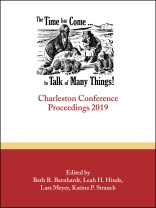Presentations from the 39th annual Charleston Library Conference (held November 4–8, 2019) are included in this annual proceedings volume. Major themes of the meeting included open educational resources, analysis and assessment of collections and library users, changes in licensing practices, virtual reality/augmented reality, journal package options, the future of print collections, and open access publishing. While the Charleston meeting remains a core one for acquisitions librarians in dialog with publishers and vendors, the breadth of coverage of this volume reflects the fact that this conference continues to be one of the major venues for leaders in the publishing and library communities to shape strategy and prepare for the future. Almost 2, 000 delegates attended the 2019 meeting, ranging from the staff of small public library systems to the CEOs of major corporations. This volume provides a rich source for the latest evidence-based research and lessons from practice in a range of information science fields. The contributors are leaders in the library, publishing, and vendor communities.
Daftar Isi
Preface and Acknowledgments
Introduction
PLENARY
The Long Arm of the Law 2019
Building Trust When Truth Fractures, by Brewster Kahle
A Collaborative Imperative? Libraries and the Emerging Scholarly Communication Future , by Beth Bernhardt, Jason S. Price, and Alicia Wise
Anticipating the Future of Biomedical Communications, by Meg White and Patricia Flatley Brennan
Collaborating to Support the Research Community: The Next Chapter, by Kumsal Bayazit and Cris Ferguson
ANALYTICS
Get It From the Source: Identifying Library Resources and Software Used in Faculty Research, by Karen S. Alcorn, Erin E. Wentz, Gregory A. Martin, Shanti C. Freundlich, and Joanne A. Doucette
Making Collection Management Manageable: A Three‐Phase Approach to an Annual Subscription Review, by Hannah Pearson
What Are Students Saying About Their Reference Needs?, by Damon Zucca
The Time Has Come…To Build, Reflect, and Analyze Connections Between Qualitative and Quantitative Data, by Jordan S. Sly, Leigh Ann De Pope, Cynthia Frank, and Stephanie Ritchie
Collections Data, Tools, and Strategy: Applying R, Tableau, and Excel to Print Assessment , by Lori M. Jahnke and Chris Palazzolo
The Forest, the Trees, the Bark, the Pith: The Circulation Rates of Works of Contemporary Literature in Ten Language Areas at the University of Oregon Libraries, by Jeff Staiger
New Usage Reports, New Insights! How to Use your COUNTER Data in Decision‐Making Processes, by Athena Hoeppner, Sonja Lendi, and Kornelia Junge
Talking of Many Things: Dashboards for Reference Services Decision‐Making, by Hui Hua Chua and Rachel M. Minkin
Communicating Collections: Strategies for Informing Library Stakeholders of Collections, Budget, and Management Decisions, by Laura Pascual, John Abresch, and Anna Seiffert
The Time Has Come for E‐Books, or Has It?, by Gabrielle Wiersma, and Leigh Beauchamp
Reference: Product Categories in the Digital Age, by Kathryn Earle
COLLECTION DEVELOPMENT
Embrace the Hive Mind: Engaging ILL and Research Services in Unsubscribed and OA Content Discovery, by Jeffrey M. Mortimore, Ruth L. Baker, Rebecca Hunnicutt, Natalie Logue, and Jessica Rigg
Tip of the Iceberg, Part 1: Choosing What Shows , by Karen Kohn
Begin at the Beginning: Revamping Collection Development Workflows, by Elyssa M. Gould and Jennifer Mezick
Six Impossible Things: Moving KBART Into the Next Decade, by Andrée Rathemacher, Robert Heaton, Noah Levin, and Christine Stohn
Primary Rights and the Inequalities of E‐Book Access, by Roën F. Janyk and Arielle R. Lomness
Change—Watch for the Right Time: Structuring Collections Budgets to Meet Current and Future Needs, by John P. Blosser
Trot So Quick: Addressing Budgetary Changes, by Star Holloway and Jeff Bailey
From Big Ideas to Real Talk: A Frontline Perspective on New Collections Roles in Times of Organizational Restructuring, by Meghan J. Ecclestone, Sally A. Sax, and Alana P. Skwarok
Down the Rabbit Hole We Go Again: The 19th Health Sciences Lively Lunchtime Discussion, by Susan K. Kendall, Ramune Kubilius, Sarah Mc Clung, Jean Gudenas, and Rena Lubker
Wrangling Weirdness: Lessons Learned From Academic Law Library Collections, by Courtney Mc Allister and Megan Brown
Matching Made in Heaven: Collections and Metadata Collaboration for Print Preservation, by Alie Visser, Erin Johnson, and Christina Zoricic
Something to Talk About: The Intersection of Library Assessment and Collection Diversity, by Roxanne Marie Backowski and Timothy Ryan Morton
Incoming!: Surviving the Barrage of Vendor Communications, by Edward F. Lener
Tangled Up in Books: Using the Lyrics of Bob Dylan to Understand the Changing Times of Collection Development, by Thomas A. Karel
Acquiring E‐Books: Does (Should) Workflow Play a Role?, by Alexis Linoski
The Time Has Come… to Move Many Things: Inventorying and Preparing a Collection for Offsite Storage, by Rachelle Mc Lain and Hannah Mc Kelvey
Strategic Reinvestments of Journal Packages at Pennsylvania State University, by Mihoko Hosoi
Canceling the Big Deal: Three R1 Libraries Compare Data, Communication, and Strategies, by L. Angie Ohler, Leigh Ann De Pope, Karen Rupp-Serrano, Joelle Pitts
Pain Points and Solutions: Bringing Data for Startups to Campus, by Kelly La Voice, Daniel Hickey, and Mark Williams
Piloting the Surge: Streaming Video and Academic Libraries, by Joanna Kolendo, Azungwe Kwembe, and Charlene Snelling
Comparison and Review of 17 E‐Book Platforms, by John Lavender and Courtney Mc Allister
The Open Landscape Environment as the Expanse, by Barbara I. Dewey
Change—Watch for the Right Time: Structuring Collections Budgets to Meet Current and Future Needs, by Caryl Ward and Jill Dixon
Resource Discovery in a Changing Content World, by Allen Jones, Cynthia Schwarz, Hannah Mc Kelvey, Rachelle Mc Lain, and Christine Stohn
When You Don’t Know What You Don’t Know: How Two New Collections Librarians Right‐Sized a Collections Budget, by Cara M. Cadena and Marcia R. Lee
Approvals, Slips, and DDA! Oh My! The Yellow Brick Road to Collaborative Approval and DDA Profiling, by Keri Prelitz
A New Synthesis: Research Resources to Research Experiences, by Thomas Hickerson
Legacy Missions in Times of Change: Defining and Shaping Collections in the 21st Century, by Antje Mays and Oya Y. Rieger
Reason Minus Zero/No Limit: Trying to Bring It Back Home, a Trilogy of University of Wisconsin–Stevens Point Collection Development, by Tom Reich
Tip of the Iceberg, Part 2: Discovering What’s Hidden, by Rich Gause
Glimpse Into the Future: Using the Curriculum Process System for Collection Development, by Jennifer M. Young
LIBRARY SERVICES
What Do Editors Want?: Assessing a Growing Library Publishing Program and Finding Creative Solutions to Unmet Needs, by Julia A. Lovett and Andrée J. Rathemacher
Dual‐Campus Subject Librarians at the University of Central Florida, by Barbara G. Tierney and Corinne Bishop
The Textbook Affordability Puzzle: Perspectives From Three of the Pieces, by Katy A. Miller, Sara E. Duff, and Penny G. Beile
Representation of Atypical Resources in the Discovery Layer: Metadata and Cataloging Aspects, by Brian J. Falato
The Time Has Come . . . to Talk About Why Research Data Management Isn’t Easy, by Carol Tenopir, Jordan Kaufman, Robert J. Sandusky, and Danielle Pollock
Let’s Give Them Something to Talk About: Textbook Affordability and OER, by Linda K. Colding, Peggy Glatthaar, Derek Malone, and Jennifer Pate
Should You Pay for the Chicken When You Can Get It for Free? No Longer Life on the Farm as We Know It, by Sharon M. Mattern Büttiker, James King, Susie Winter, Crane Hassold
Reconsidering Literacy, by Audrey Powers and Marc Powers
MANAGEMENT
Leading From Below: Influencing Vendors and Collection Budget Decisions as a Subject Liaison, by Min Tong, Cynthia Cronin-Kardon, and Steve Cramer
Great Expectations: Leading Library Staff Through the Minefield of Continuous Change, by Denise Novak and Corey Seeman
Migrating to Alma Without an Acquisitions Staff: Evolving Acquisitions and Electronic Workflows From Their Legacy Silos, by Jennifer K. Matthews and Christine Davidian
SCHOLARLY COMMUNICATION
The Time Has Come . . . for Next‐Generation Open Access Models, by Celeste Feather, Sara Rouhi, Anneliese Taylor, and Kim Armstrong
Rejuvenating Green OA for a Greener Pasture, by N. V. Sathyanarayana
Maximum Dissemination: A Possible Model for Society Journals in the Humanities and Social Sciences to Support “Open” While Retaining Their Subscription Revenue, by John G. Dove
Your IR Is Not Enough: Exploring Publishing Options in Our Increasingly Fragmented Digital World, by Adam C. Blackwell
Falling Down the Rabbit Hole: Exploring the Unique Partnership Between Subject Librarians and Scholarly Communication, by Sandra Avila, Ven Basco, and Sarah A. Norris
Intriguing New Model for Improved Visibility and Access to Theses and Dissertations, by Chelsea T. Johnston and Judith C. Russell
Professional Learning and Inbetween Publishing: The Tasks of the Charleston Briefings, by Steven Weiland and Matthew Ismail
Lessons From Ithaka S+R on Research Practices in the Disciplines: What Have We Learned? What Should We Do?, by Steven Weiland and Jennifer Dean
A Proposed Framework for the Evaluation of Academic Librarian Scholarship, by Rachel Borchardt, Polly Boruff-Jones, Sigrid Kelsey, and Jennifer Matthews
MIT Press Direct and University of Michigan Press Ebook Collection: First‐Year Lessons Learned and Future Prospects, by Emily Farrell, Lanell White, and Sharla Lair
TECHNOLOGY AND TRENDS
Introducing Seamless Access.org: Delivering a Simpler, Privacy‐Preserving Access Experience, by John Felts, Tim Lloyd, and Emily Singley
The Sun Shining in the Middle of the Night: How Moving Beyond IP Authentication Does Not Spoil the Fun, Ease, or Privacy of Accessing Library Resources, by Michelle E. Colquitt
Hacking for Good—Workshop Summary, by Alex Humphreys, Heather Ruland Staines, Geoffrey P. Timms, and Caroline Muglia
UP AND COMING
Mind the Gap: A Landscape Analysis of Open Source Publishing Tools and Platforms, by John W. Maxwel
The Big Deal Is Dead! Long Live the Big Deal!, by James Galbraith and Stephanie Hess
Index
Tentang Penulis
Beth R. Bernhardt is consortia account manager for Oxford University Press, and she formerly worked as the assistant dean for Collection Management and Scholarly Communications at the Jackson Library, University of North Carolina at Greensboro.Leah H. Hinds is the executive director of the Charleston Conference, and she has served in various roles with the Charleston Information Group, LLC, and Against the Grain/ATG Media since 2004. Lars Meyer is the director of Access and Resource Services at Emory University Libraries with responsibilities for access services, technical services, preservation, and digitization.
Katina P. Strauch is the founder and convener of the Charleston Conference, and editor of Against the Grain, the journal linking publishers, vendors, and librarians, which is issued six times a year. She recently retired as the assistant dean of Technical Services and Collection Development at the Addlestone Library, College of Charleston.












